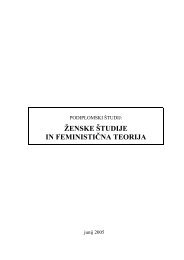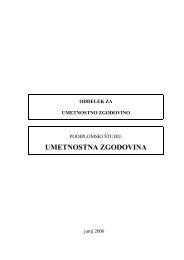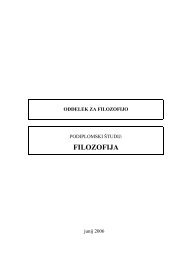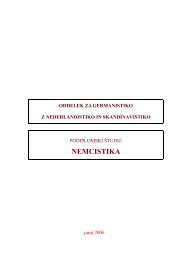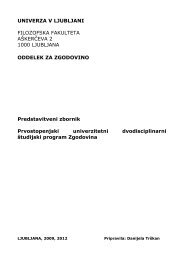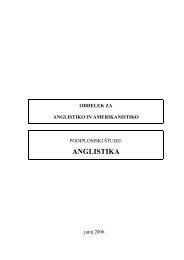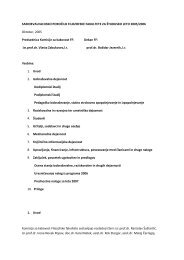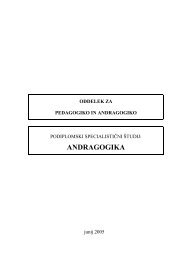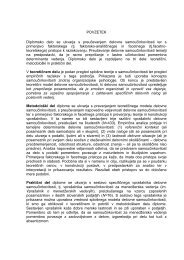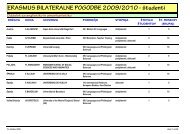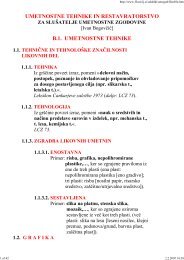LINGUISTICA XLIX - Filozofska fakulteta - Univerza v Ljubljani
LINGUISTICA XLIX - Filozofska fakulteta - Univerza v Ljubljani
LINGUISTICA XLIX - Filozofska fakulteta - Univerza v Ljubljani
Create successful ePaper yourself
Turn your PDF publications into a flip-book with our unique Google optimized e-Paper software.
hOPPER, Paul J./Sandra A. ThOMPSON (1980) “Transitivity in grammar and discourse.”<br />
language 56, 251–299.<br />
MAyERThALER, Willi (1981) morphologische natürlichkeit. Wiesbaden: Athenaion.<br />
MAyERThALER, Willi/Günther FLIEDL/Christian WINKLER (1998) lexikon der natürlichkeitstheoretischen<br />
syntax und morphosyntax. Tübingen: Stauffenburg.<br />
OREŠNIK, Janez (2007a) “Natural Syntax: Negation in English.” Poznań studies in<br />
contemporary linguistics 43, 97–111.<br />
OREŠNIK, Janez (2007b) “Natural syntax: the grammatical person of personal pronouns.”<br />
sprachtypologie und universalienforschung 60, 293–313.<br />
OREŠNIK, Janez (2007c) “Natural syntax: English interrogative dependent clauses.”<br />
razprave 20 [Razred za filološke in literarne vede SAZU Ljubljana], 191–208.<br />
OREŠNIK, Janez (2007d) “Natural syntax: English dependent clauses.” studia anglica<br />
Posnaniensia 43, 219–236.<br />
OREŠNIK, Janez (2007e) “Natural syntax: English interrogative main clauses.” linguistica<br />
47, 35–48.<br />
OREŠNIK, Janez (2008) “Natural syntax: English relative clauses.” Poznań studies in<br />
contemporary linguistics 44, 61–101. <br />
SADOCK, Jerrold M. (1980) “Noun incorporation in Greenlandic: A case of syntactic word<br />
formation.” language 56, 300–319.<br />
Summary<br />
TRANSITIVITy IN NATURAL SyNTAX: ERGATIVE LANGUAGES<br />
The paper implements the framework of Natural Syntax and treats various phenomena bearing<br />
on transitivity using the language material of ergative languages. In each case one ergative and<br />
one antipassive constructions are compared, and certain properties of such pairs are predicted.<br />
It is new in the paper that it is necessary to distinguish less or more transitive antipassive constructions.<br />
In the more transitive ones the agent and the patient are coded with the ergative<br />
case, the absolutive case, the nominative case, or the patient is integrated (at least to some<br />
extent) into the corresponding verb. More transitive antipassive constructions and the corresponding<br />
ergative constructions remain transitive. Because transitivity represents an unnatural<br />
environment, the alignment of the corresponding naturalness values is chiastic. The remaining<br />
antipassive constructions are less transitive, so that any pair consisting of such a construction<br />
and of the corresponding ergative construction withdraws from the unnatural environment of<br />
transitivity, and hence the alignment of the corresponding naturalness values is parallel.<br />
Another unnatural environment is represented by the patient just in case that its syntactic, not<br />
semantic, properties are treated. Consequently the alignment of the corresponding naturalness<br />
values is chiastic. The paper discusses 18 ergative languages, mostly from the Caucasus and the<br />
Pacific Ocean.<br />
92



